Adam Yamey's Blog: YAMEY, page 237
June 8, 2013
IN LEAR'S FOOTSTEPS
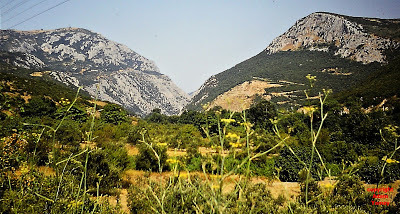 This is an excerpt from the draft of Adam Yamey's new book, which will be called "SCRABBLE WITH SLIVOVITZ - Once Upon a Time in Yugoslavia". The book is a trail of memories of the many visits that I made to Yugoslavia and its neighbours during the years leading up to 1991. More information about the forthcoming book is available by clicking HERE .
This is an excerpt from the draft of Adam Yamey's new book, which will be called "SCRABBLE WITH SLIVOVITZ - Once Upon a Time in Yugoslavia". The book is a trail of memories of the many visits that I made to Yugoslavia and its neighbours during the years leading up to 1991. More information about the forthcoming book is available by clicking HERE .The pictures, which Adam took in 1979, were made whilst the events that he describes were unfolding.
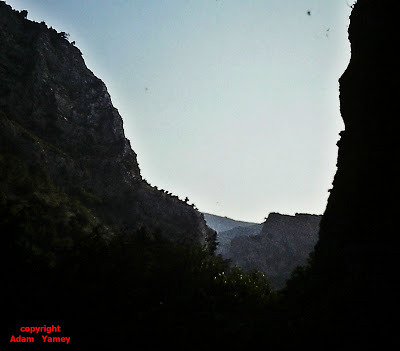
The Vale of Tempe
"The main railway line, which connected Belgrade with Skopje and Salonika, passed through the middle of the town and was used as a footpath by many of the townsfolk. Seeing this reminded me of something that I did many years earlier in northern Greece.
In the late 1840s, the artist and poet Edward Lear walked through the Vale of Tempe. He had been particularly enamoured of this 10 Km section of the River Pineios, where it squeezes between the slopes of Mounts Olympus and Ossa. Having seen his illustration of it, I thought that it would be fun to attempt to retrace his footsteps. Robert and Margaret, with whom I was camping in the nearby seaside town of Platamon, kindly drove me along the modern road that skirts the Vale. It was so high above it that almost nothing could be seen of the valley far below. They deposited me at the southern end of it, and arranged to meet me a few hours later at its northern end.
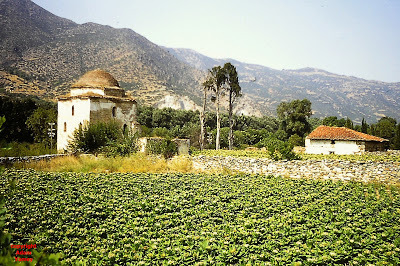
Southern end of Vale of Tempe
I did not want to go along the valley the way we had come by car because I wanted to try to follow the path taken by Lear. As Robert and Margaret drove away leaving me standing by the roadside, I noticed two shepherds sitting on a slope. My Greek was not good enough to ask them the way to the place which I wanted to reach at the other end of the valley, but by pointing at my feet and walking a little, they understood me, and pointed at the railway track running along an embankment behind and far above them. I climbed up to the railway and began walking along the narrow path beside it.
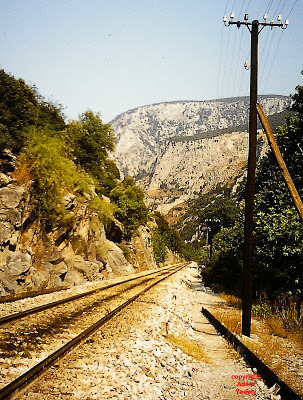
The railway fromAthens to Salonika passing through the Vale of Tempe
After a few minutes, I heard a sound behind me. Soon, the numerous carriages of the Athens to Munichexpress rumbled past me, heading on its way towards Yugoslavia. I continued on my way and followed the track into a deep narrow cutting between two high walls of roughly hewn rock. Almost without any warning a single diesel locomotive came dashing around a bend towards me. I pressed myself into the wall behind me and hoped that I would not be sucked towards the hurtling locomotive as it swept past me. I lived to tell the tale, and continued through the cutting and back out into the open, following the track along a high embankment from which I could just about see the river far beneath me.
A few hundred metres ahead of me, I saw the entrance to a tunnel. As I could not see the other end of it, I guessed that it might have been a long one. With my recent hazardous encounter with the locomotive in the forefront of my mind, I decided not to enter it. However, I had already come quite a distance, and did not want to retrace my steps. To avoid entering the tunnel, I scrambled, or rather slid, inelegantly down the steeply inclined scree-covered embankment, and reached a pathway far below, but close to the river.
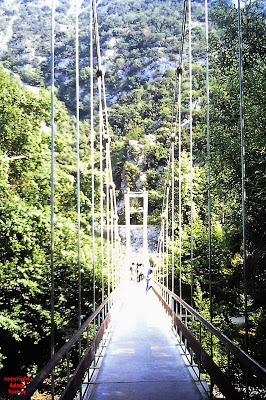
Footbridge at Aghia Paraskevi in the Vale of Tempe
I realised that this is where the two shepherds had meant that I was to walk. It was the bed of a disused railway track. The rails had been removed and it made a perfect footpath. It followed the river, only a few feet above it. I breathed a sigh of relief, and walked along enjoying the kind of Arcadian landscape that Lear had sketched, as well as the peace and quiet. Near the northern end of the Vale, I arrived at what must have once been a station. It had been converted into a Greek Orthodox pilgrimage place complete with a refreshment stall. Soon after arriving there, I met up with Robert and Margaret, and related my hair-raising adventure to them."
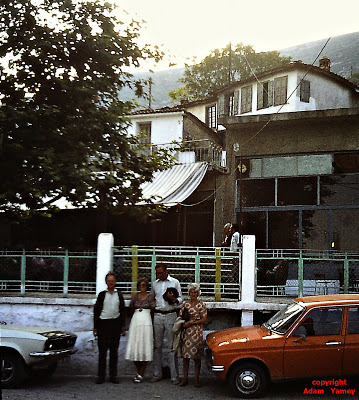
Robert (far left) and Margaret (far right) in Rapsani, a village on the slopes of Mount Olympus
Adam Yamey is the author of two novels about 19th century South Africa and a travel memoir about Albania. Click HERE for more information about these publications
Published on June 08, 2013 03:54
May 26, 2013
TUBES
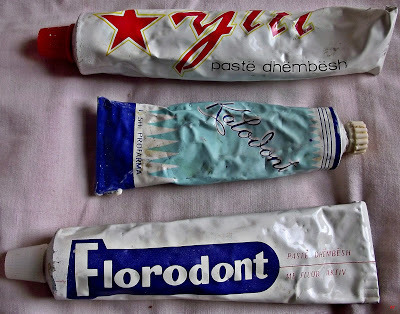
Gjirokastër, Albania in May 1984
"That evening after dinner, a number of us sat with Aferdita and Eduart in the hotel’s night club. Each of the hotels in which we stayed had one of these. With the exception of our two guides and the musicians who performed in them, these clubs were out-of-bounds for Albanians. This evening we were entertained by a small band that played western pop music, mainly tunes originally performed by the Beatles. The noisy background of these clubs provided our two young guides with opportunities to ask us about life beyond their country’s tightly sealed borders. However, it was clear that Aferdita was trying to eavesdrop on Eduart and vice-versa. As the musicians strummed away in the semi-gloom of the club in Gjirokastër, Aferdita turned to me, rolled her lower lip away from her teeth, and asked my opinion of her gums. She wanted to know if they had been treated properly. I told her that I was unable to give her an opinion in such poor light.
The following morning, I spotted some tubes of Albanian toothpaste on display in a locked glass display case near the hotel’s main entrance. I tried to communicate to the receptionist (who did not understand English) that I wished to purchase a tube. I used to collect toothpastes from wherever I travelled, and was curious to taste its contents. Whilst I was doing this, Aferdita appeared, and asked me what I wanted. I told her. She explained my desire to the receptionist, and moments later I had become the proud owner of a tube of Albanian dentifrice."
This is a brief excerpt from my book "ALBANIA ON MY MIND" (Click HERE for more detail), published in 2012. Until two days ago, I had believed that I had lost or thrown away the Albanian toothpaste bought in Gjirokastër,to which I referred in the excerpt. Well, I found it amongst some goods that we had kept in storage for almost 20 years. The illustration below shows 2 of the tubes in greater detail:
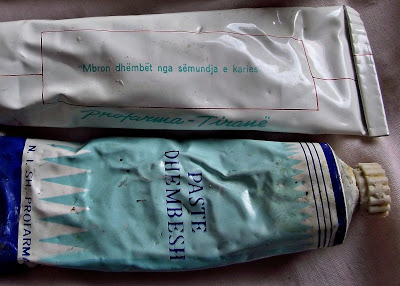
These were not the only dental souvenirs that I discovered in our family storage locker. Here is an extract from the draft of my forthcoming book "SRABBLE WITH SLIVOVITZ - Once Upon a Time in Yugoslavia" about Yugoslavia before 1991:
"Between Niš and the dull, nearby Niška Banja, we encountered a large number of Russian and Bulgarian cars parked by the side of the main road. Each car had a stall - usually a folding table - set up beside it. Their owners were selling a wide variety of odds and ends. I bought tubes of toothpaste manufactured in the USSR and the People’s Republic of China. For a long time these, and the dentifrice that I had bought in the Albanian town of Gjirokastëra few years earlier, shared pride of place in my large collection of toothpastes from all around the world. Sadly, this collection no longer exists, and I have also lost the Russian toothbrush, which I bought there."
This section is now going to need re-writing, as I have found the missing toothpastes...
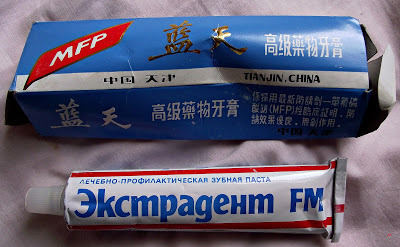
Sadly, the Russian toothbrush remains missing!
For more information about my forthcoming book about Yugoslavia as it was,please click HERE
Also, do pay a visit to http://www.adamyamey.com
Published on May 26, 2013 08:23
May 3, 2013
La Grande Illusion
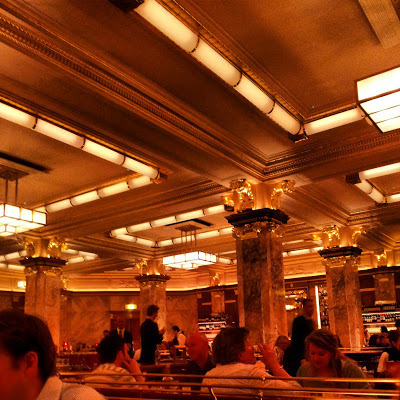
"A French lesson well learned at this reasonably priced Soho brasserie.... you will eat better here than in comparable establishments in Paris."[Fay Maschler, restaurant critic writing about Brasserie Zedel.]
Ever since we first heard about it, we wanted to pay a visit to Brasserie Zedel, which is located in a small street near to London's Piccadilly Circus. We read good reviews of it in the press and friends reccommended it highly, warning us that it was necessary to book a table well in advance. We did as advised, and reserved the table at which we dined this evening.
From the moment that you step through its doors you are transported into the world of Art Deco. Though recently created, the decor cannot be faulted. The lively dining room was a tastefully glitzy marvel. The menu was full of promise: not too many items, but sufficient variety. We were served with good bread and glasses of water whilst we made up our minds about our choices. The waitress, who took our order, seemed to have difficulty understanding what we wanted. Perhaps, the background noise affected her hearing, or maybe her English was poor.
Things got off to a poor start when instead of the Parfait de Foie de Volaile that we had ordered, we were served a plate of Pate de Campagne de Maison, and were warned that it may contain pork. This was quickly rectified when we pointed out what had happened. My Soupe de Poisson et sa Rouille arrived as ordered. But what arrived was not quite what I expected. The soup that tasted no better than cheap fish soup from a can was lukewarm. There was no pot of rouille accompanying it. There were two tiny slices of toast next to the soup bowl. Each of these bore squidges of something resembling soft chewing gum to which was attached a few thin strands of cheese. Dutifully, I added these unappetising looking morsels to the soup. The chewing gum-like material dissolved in the soup, but did not improve its flavour in the slightest. My wife and daughter received their parfait, which was far from perfect.
The main courses arrived somewhat ominously covered by the kind of plastic lids used in NHS hospitals to keep patient's food warm.
My daughter had ordered the promising sounding Poulet au Champagne. This had the appearance of something that had been cooked long ago and had then been left under a hot lamp to keep it warm. I tried a bit of the chicken; it was almost completely desiccated. My wife tried the dish of the day: Panaché de Poisson, Sauce Safran. Sounds promising, doesn't it?What arrived was a plate of rice on top of which there was an assortment of seafood fragments, a few pieces of chopped-up raw tomato, and a dried up stain, which might have once been a sauce. This dish, like the chicken, had a tired look about it. My Vol-au-Vent au Fruits de Mer looked less appetising than British Airways food in World Traveller Class (i.e. Economy Class), and tasted no better. The pastry case housing the slimy mixture of melancholic marine morsels and some ill-definable tasting sauce was far from being crumbly; it almost resisted being cut by a knife and was as tough as biltong. As for the overpriced and boring Salade Verte and the Pommes Frites that might well have been fried yesterday, the less said the better. Nothing that we were served tasted fresh.
I summoned the floor manager, and expressed our disappointment with the food, but said that as we had eaten much of it because we were hungry, we would settle what we owed. She apologised gracefully, and reduced our bill substantially. We left the establishment feeling let down.
It is a shame that we cannot agree with the usually reliable Fay Maschler, whose words, which I quoted above, were published on Zedel's website.
To cheer ourselves after the meal, we repaired to Bar Italia in nearby Frith Street. This is a place where the décor is as much fun as at Zedel but is completely authentic. It has been a landmark in Soho since 1949, and the products, which it offers, are of the highest quality. Unlike Brasserie Zedel, it is more than simply a grande illusion.
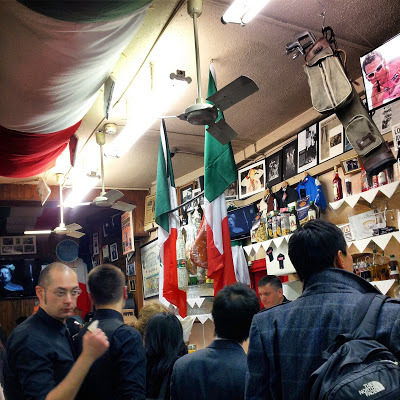
Find out about Adam Yamey's published works
by
clicking here
Published on May 03, 2013 15:30
April 13, 2013
LIVERPOOL - The Friendly City
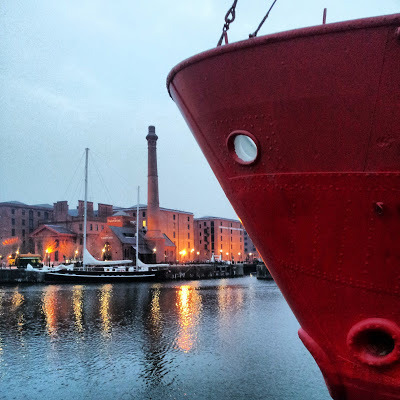 Albert Dock, Liverpool
Albert Dock, LiverpoolWhilst I was a research scientist in the early 1970s, we wmployed a young girl from Liverpool to work as a laboratory technician. She was ideal for the job, but after two weeks she announced that she had to go back to her home town. When asked why, she explained that she liked the work and her new colleagues, but did not like London. She explained that in Liverpool everyone talked to each other on the bus, but in London nobody did; she could not live in sauch an unfriendly city. So when our daughter said that she wanted to see the 'Glam' exhibition at the Tate Liverpool, we decided to go there for 3 days to see that and also the city that everyone describes as being so friendly.
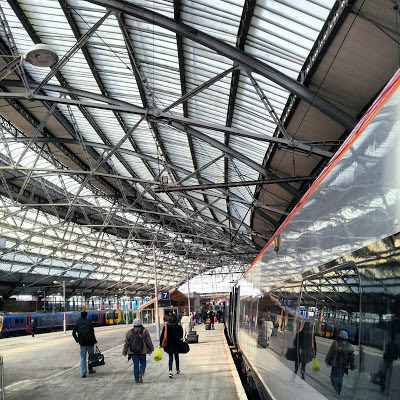
We arrived at Lime Street Station (see above). It was built in 1849, and is a masterpiece of early industrial architecture. We made our way to the highly restored Albert Docks. I left my wife and daughter to explore the Tate (see below) and wandered along the Mersey waterfront.
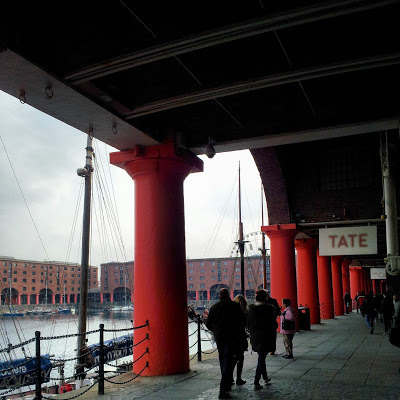
The spectacular new Museum of Liverpool faces the Albert Docks. Its exterior is oddly shaped, but visually interesting:
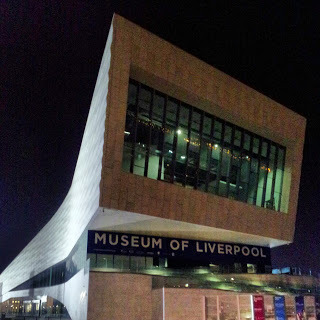
So is its interior (see below), which brings to mind the Guggenheim Museum in Manhattan.
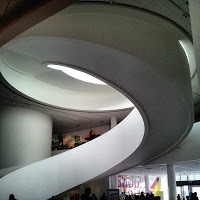
Further along, the waterfront is dominated by a series of buildings that look as if they had been transported from the USA, the destination for many people who passed through Liverpool during its heyday as a port.
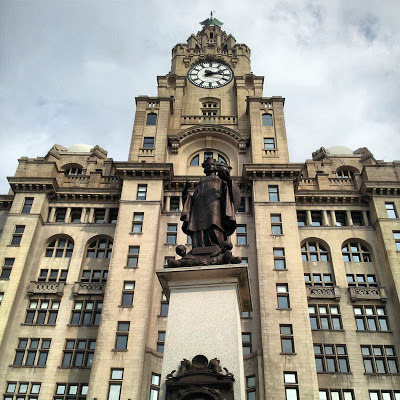
The Liver Building (above) is one of these, and is one of of the most famous landmarks in Liverpool. A couple of other buildings that would not look out of place across the Atlantic neighbour this building surmounted by its iconic 'Liver Birds'. For example, this one, which is illustrated below:
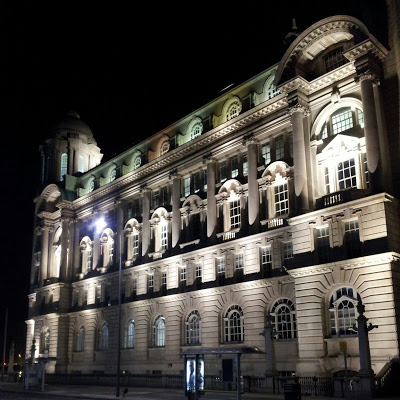
After looking at some of the numerous monuments that punctuate the waterfront (see below for example), I returned to join the family at the Tate.
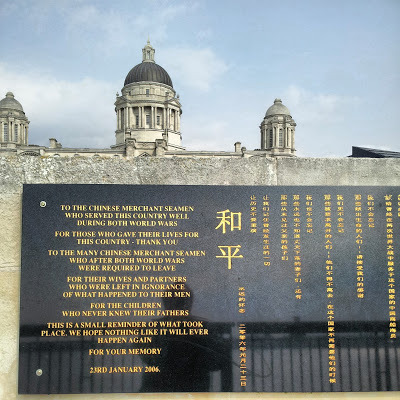
The Tate Liverpool was disappointing. It is not a good reason for visiting Liverpool. Apart from the temporary 'Glam' exhibition, which I did not see, the rest of its exhibits are meagre in quantity.
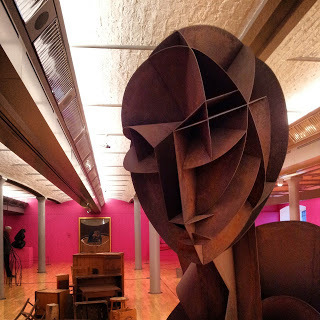 Inside Tate Liverpool
Inside Tate LiverpoolA lady on the train reccomended that we saw the Museum of Slavery, which is housed next to the Tate in the Albert dock. It was a poor reccommendation unless you are keen on 'dumbing down' and excessive 'political correctness'. The Museum of Liverpool deals with the subject of slavery much more intelligently.
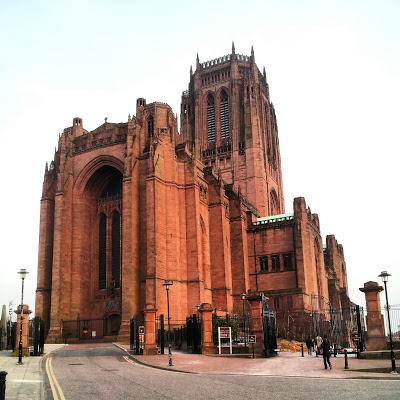
After a brief rest, we headed for Chinatown, where we planned to eat. It lies beneath the South side of St Georges Cathedral (see above), which also overlooks a sunken park (see below) reached by a path that runs through a tunnel:
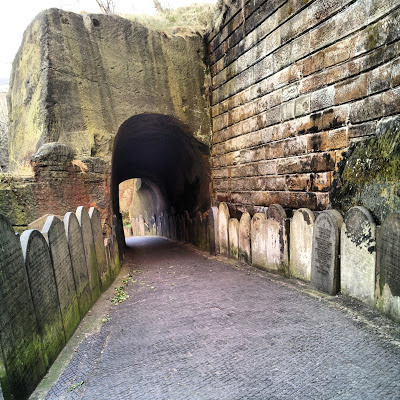
Liverpool's Chinatown is a complete contrast to London's Gerard Street, or even Queensway. It looked almost lifeless, and, apparently, is so apart from at Chinese New Year. The small heart of Chinatown is graced by a spectacular gateway:
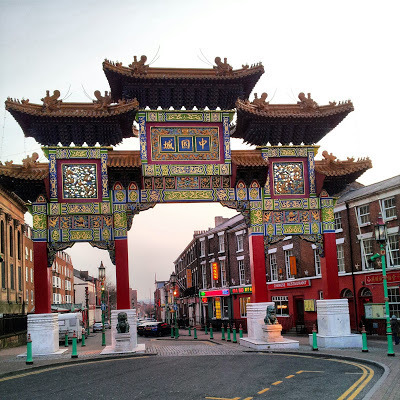
We ate dinner in the only crowded restaurant that we saw. All of the others were practically empty of diners. The food was satisfactory, but not as good as we are used to eating in London's Chinese restaurants. We shared a table with a couple of shy Chinese students, who were studying in the University of Durham. They were not too impressed bywhat they had ordered.
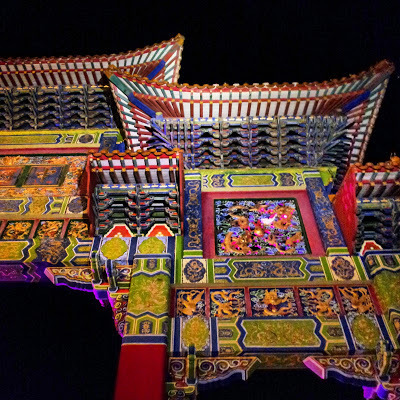
Before retiring for the night, I walked around taking a few photographs of the waterside area:
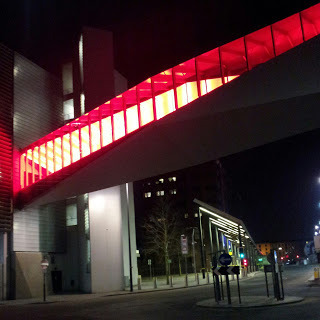 Bridge across Canning Place
Bridge across Canning Place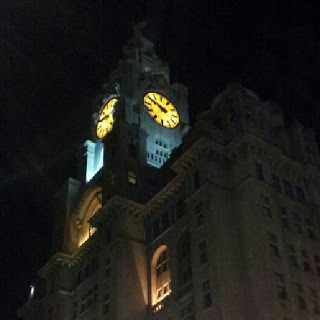 The Liver Building
The Liver Building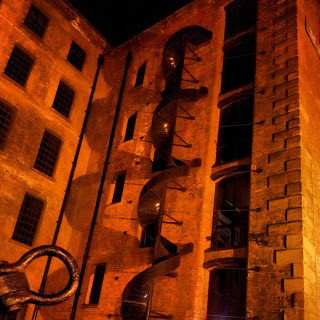 The Maritime & Slavery Museums
The Maritime & Slavery MuseumsNext morning we boarded the Liverpool to Birkenhead ferry - 'ferry across the Mersey' made famous in a song first sung by Gerry and the Pacemakers in 1964 . Our boat's departure was delayed because we had to wait for 6 foreign warships, which had been visiting Liverpool, to 'clear' the river before we could set sail. The picture below shows the departure of a Polish warship being supervised by a tug:
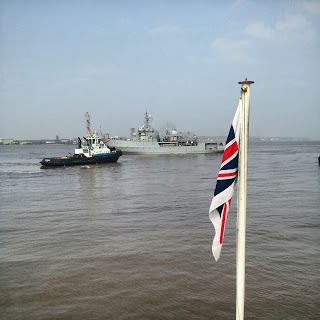
After a 30 minute cruise towards the estuary and then back upstream to Woodside, a port close to the entre of Birkenhead, we disembarked, completely windswept and numbed with cold.
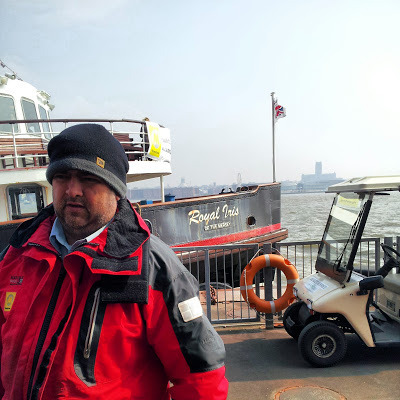 The Mersey ferry at Woodside with the silouhette of St Georges Cathedral on the horizon
The Mersey ferry at Woodside with the silouhette of St Georges Cathedral on the horizonIt is a short walk from the ferry station to the elegant Hamilton Square in the town of Birkenhead that lies across the Mersey from Liverpool. The square, built in the late 18th/early 19th century is a gem:
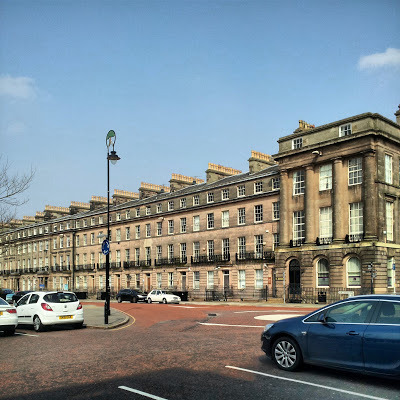
One side of this beautiful urban space is occupied by Birkenhead Town Hall:
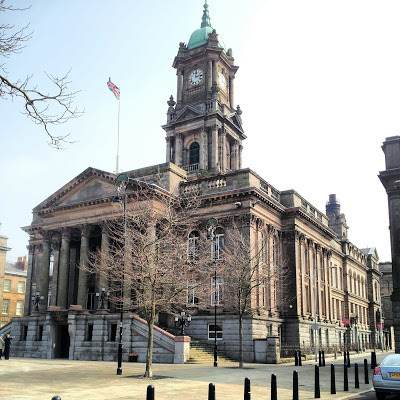
After eating a quick but delicious lunch at Dempsters café near to Hamilton square we boarded a Merseyrail train:
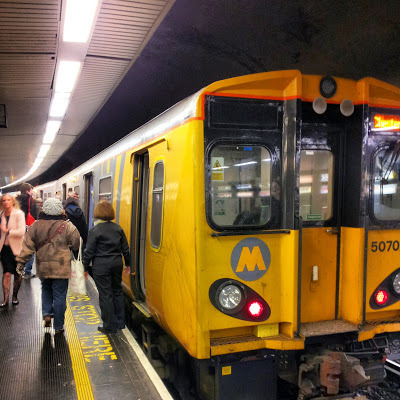
We disembarked at Port Sunlight Village. This is a housing estate that Lord Leverhulme built in the late 19th/early 20th century for the workers at Lever Bros. soap factory, which was located nearby. It is a wonderful collection of buildings in the Arts and Crafts Movement style.
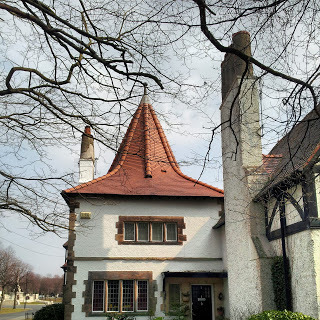
There is a war memorial in the centre of the village:
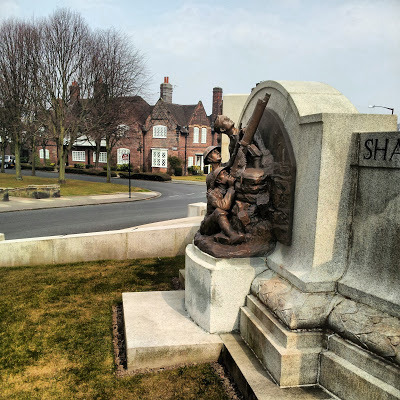
It is a somewhat sentimental work of art:
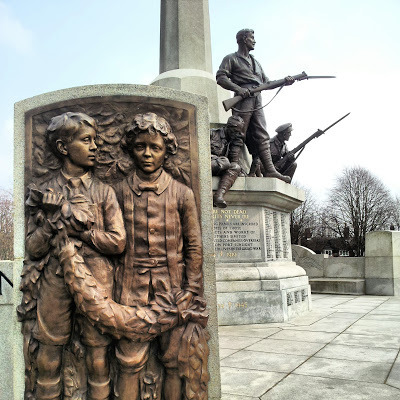
Port Sunlight is the home of the superb Lady Lever Art Gallery, which contains a superb collection of paintings and sculptures. The collection is particularly rich in pre-Raphaelite works. One of these, painted by Holman Hunt, contains the portrait of Mr Cama, a Parsi. He can be seen wearing a red cap on the right in the detail below:
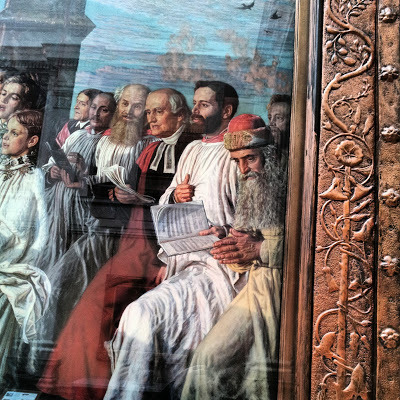
The toilets at the museum seem to have retained a number of original features:
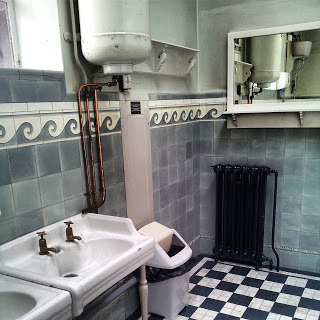
After exploring the Gallery thoroughly, we took the Mersey rail train under the Mersey and into the centre of Liverpool. We poked our heads into the Adelphi Hotel. Now looking a little faded, this hotel included FD Rooseveldt and Frank Sinatra amongst its guests:
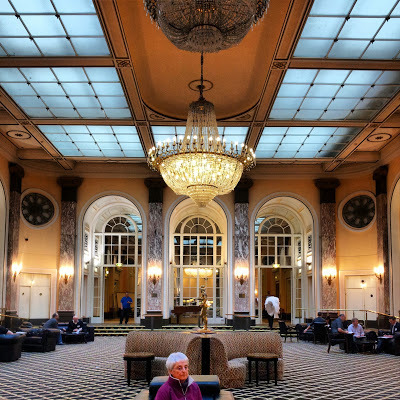
We made our way from the hotel to the Roman Catholic Cathedral, which was designed by Gibberd and consecrated in 1967:
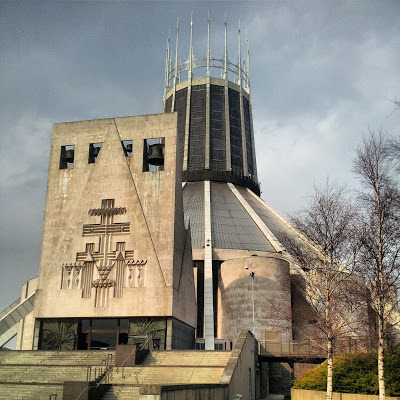
Entering this building is a truly uplifting experience. Light filters throug the stained glass in the crown surmounting the building and floods the interior with coloured light:
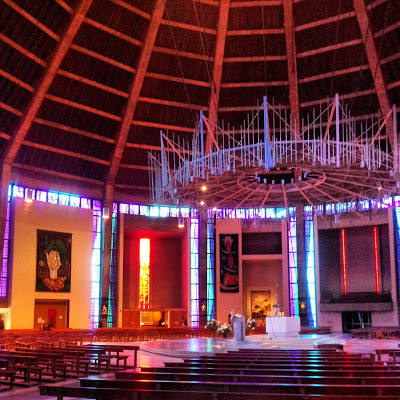
The walls of the circular cathedral are punctuated by alcoves containing fine works of art such as the sculpture of the Burning Bush shown below:
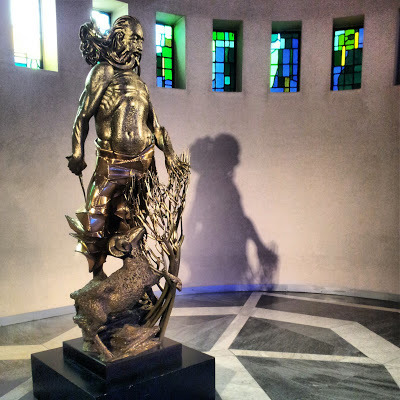
Hope Street connects the Roman Catholic Cathedral with the Anglican Cathedral of St George. Half way along this street we came across some curious street art:
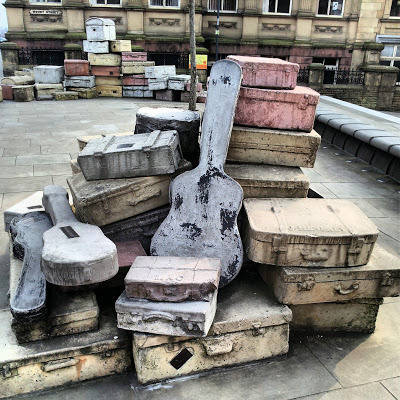
Whereas the Roman Catholic Church feels uplifting and light, St George's Cathedral, designed by Sir Gilbert Scott, is overawing and grandiose:
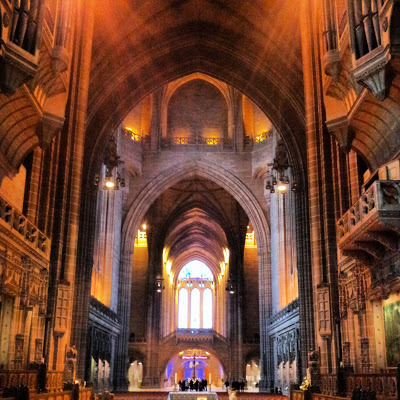
When we arrived, its nave was being prepared to serve as a dining room for a congress of physicists:
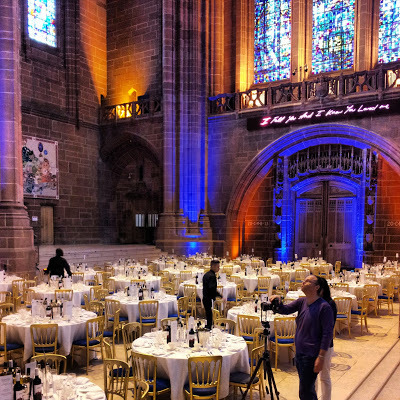
For me, the highlight of St Georges was the Lady Chapel:
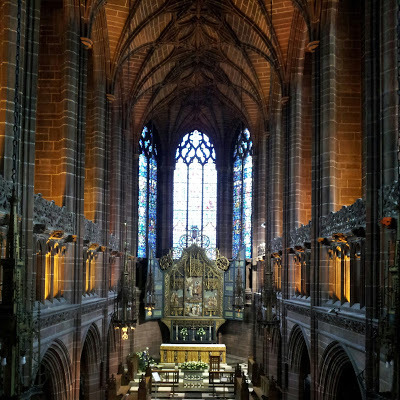
We ate a more than satisfactory dinner at Bistrot Franc near to the waterfront, and then retired to bed, exhausted.
We left our hotel next morning, and passed a building whose brickwork and design reminded me of the old New Scotland Yard:
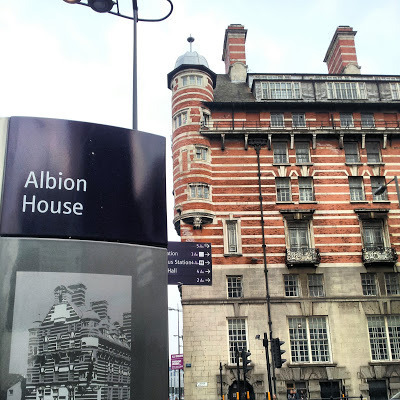
Indeed, Albion House, the former headquarters of the White Star shipping line, was built by the same architects, Shaw and Boyd, who built the building in London a few years ealier in 1887.
Our next port of call was the Museum of Liverpool, a superbly displayed collection of exhibits relating to the history of the city and its people. There was a particularly horrific exhibition about the Chinese men who were forcibly repatriated after WW2, leaving many wives and children to face destitution (see illustration of their memorial above). The museum also makes it clear about the role that city played in the trade triangle that involved sending slaves from Africa to America; sugar and cotton to Liverpool; and manufactured goods, including ships built in the city, left Liverpool for use in Africa and America. Later, the city became an important departure point for Europeans seeking a better life in the USA. Today, the city seems like a pale shadow of its former self. A man with whom we spoke when we were on the train to Port Sunlight told me that a visit to Dingle in the southern part of Liverpool would allow me to see an area that evoked the era before WW2 . I took a bus towards Toxteth, the site of much rioting in 1981. At the suggestion of an elderly man in the Museum of Liverpool, I disembarked. at the beginning of Dingle Lane On one side of the road, there stands a derelict cinema:
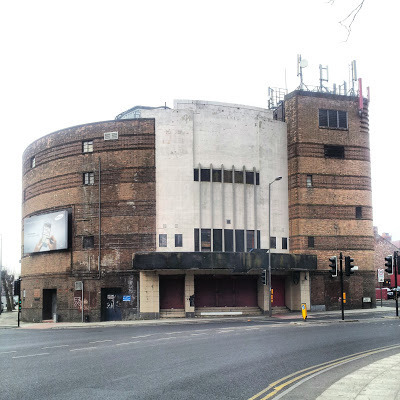
Opposite the cinema, there stands the Ancient Chapel of Toxteth that dates back to about 1615. A dissenter's chapel, one of its preachers Richard Mather , who was twice suspended from the ministry, emigrated from there to the USA in 1635. Sadly, the chapel is only opened by prior arrangement, and I had insufficient time to arrange this...but, next time I will make sure that get inside!
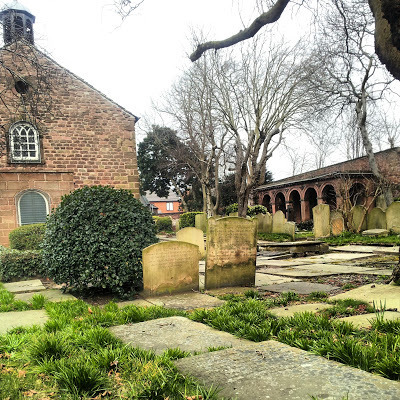
I walked for a few minutes through some unexceptional post-WW2 housing estates until I reached Cockburn Street in Dingle. A number of small but steep streets meet this at right angles and descend to a parallel road that runs along a cliff overlooking the docks along the Mersey. These streets reminded me of those that can be seen in abundance in South Wales mining towns.
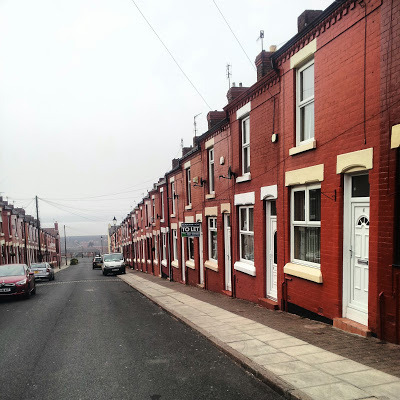 Looking downhill
Looking downhill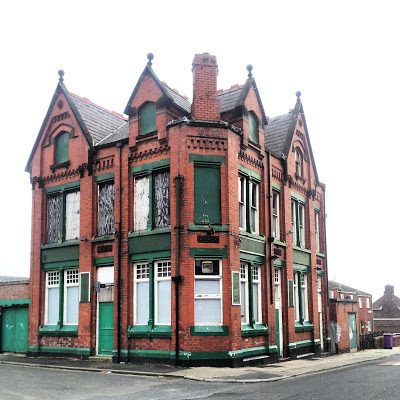 Abandoned pub, Cockburn Street
Abandoned pub, Cockburn Street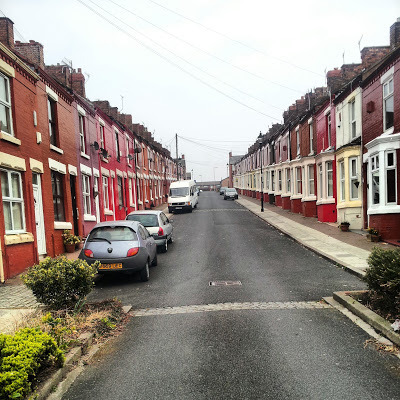 Looking uphill
Looking uphillBefore reaching the series of streets just described, I had noticed some curious domes on the horizon. These were part of the beautifully restored Florence Boys Institute, which was built in 1889 and is affectionately known as the 'Florrie'. It was named after Florence, the daughter of Sir Bernard Hall who was an East India merchant. Formerly, a boy's social club, it is now an urban regeneration centre:
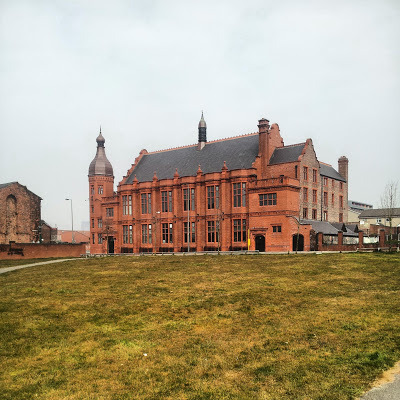
There is a monument to Florence on the staircase that leads up to a large first floor hall with a hammer-beam roof:
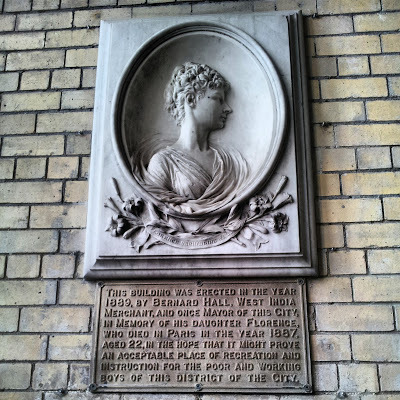
I rejoined the rest of the family to eat lunch in a spectacularly decorated art-nouveau pub on Hope Street, The Philharmonic:
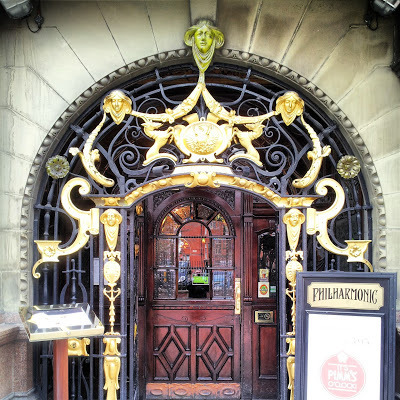
We enjoyed well-prepared, good food in its spacious dining room:
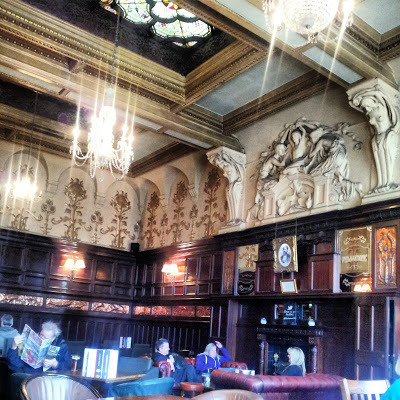
My wife and daughter went by bus to the Walker Art Gallery. I walked. In Mount Pleasant Street, I spotted a second hand bookshop:
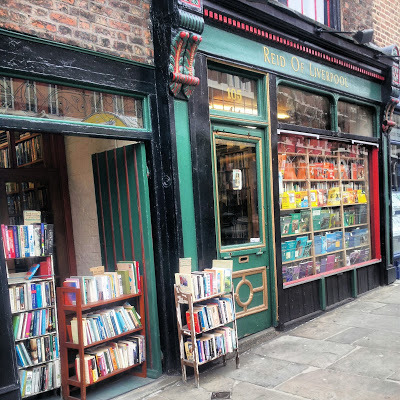
After spending a few minutes browsing, but not buying, I continued walking downhill until I reached Lime Street. On the way I passed two interesting old buildings, a former Methodist hall:
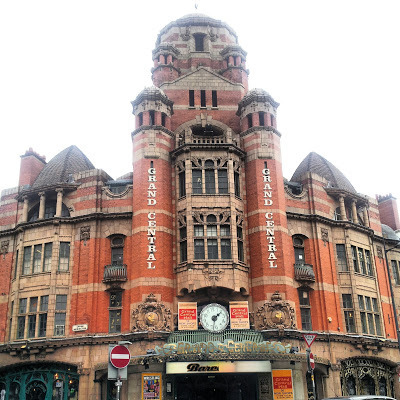
and an old cinema, the Picture House:
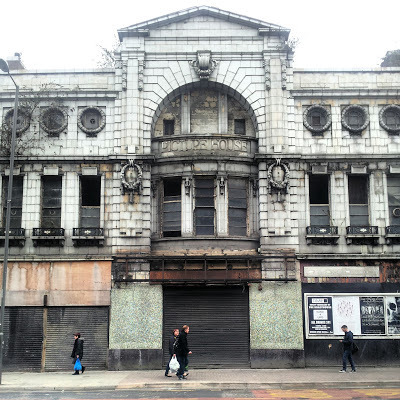
Next, I entered St George's Hall, an impressive neo-classical building almost opposite Lime Street Station. A series of arrows guides the visitor around the interior of this vast building. The highlight of this interesting place is St George's Hall:
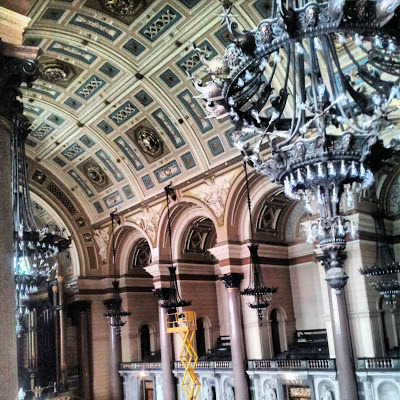
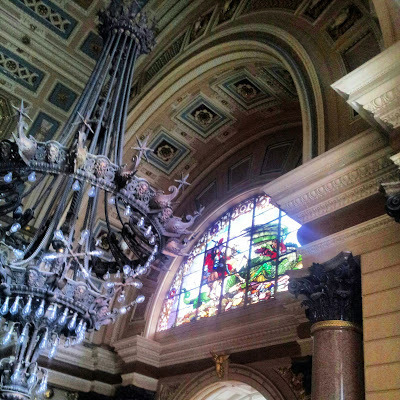
The hall is a testament to the city's former power and wealth. It overlooks a small park which is filled, as is much of central Liverpool, with memorials and monuments:
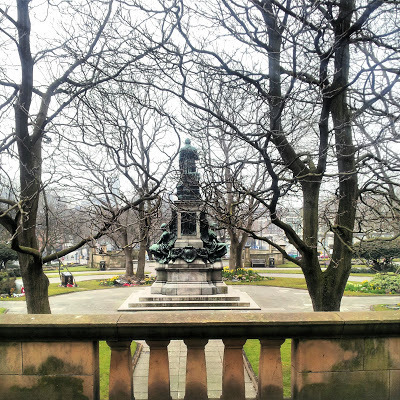
If one was be short of time and wanted to visit an art gallery in Liverpool, the Lady Lever Gallery in Port Sunlight rather than the Walker (illustrated below) would be my choice.
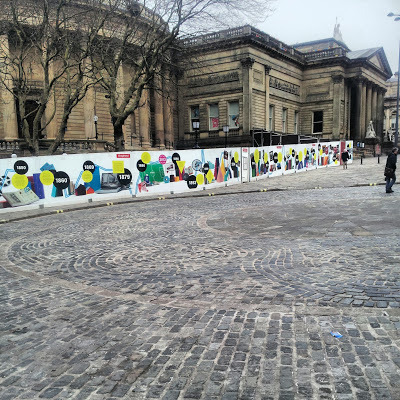
Despite what I have just written, the Walker is certainly worth a visit. Apart from a rich collection of paintings including at least one Rembrandt, there are some quirky pieces such as the 'Loophonium' (also known as the 'Harpic-chord'), which plays a familiar tune when a button is activated:
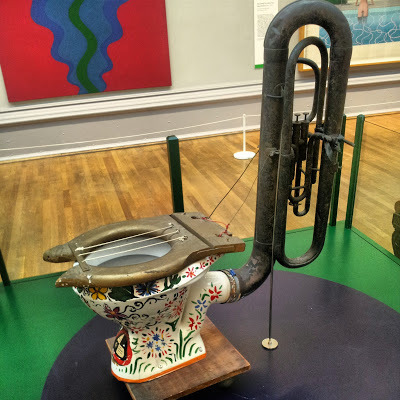
No visit to Liverpool is complete without a visit to the Cavern Club where the Beatles played in their early years:
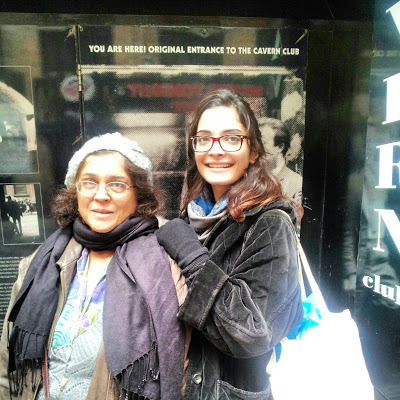
Near the Cavern Club, there is a peculiar monument to Carl Jung, one of the founders of Psychoanalysis, who said in 1927, "Liverpool is the pool of life":
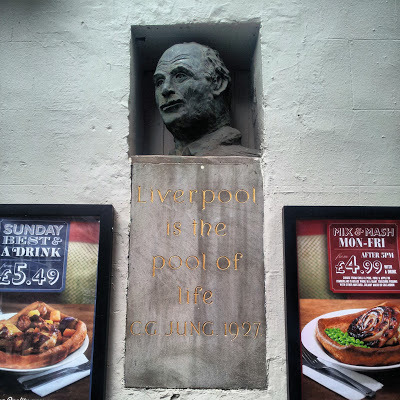
Jung never actually visited Liverpool. His words came to him in a dream.
We visited Liverpool, and spent 3 days there. Did we find it to be a friendly city? Although we were not there long enough to answer this properly, my answer must be that it was certainly not unfriendly, but on the other hand it was no friendlier than many places that I have visited. Nevertheless, I cannot wait to visit it again!
I leave you with a picture of a curious creature that pervades the city, a 'lambanana':
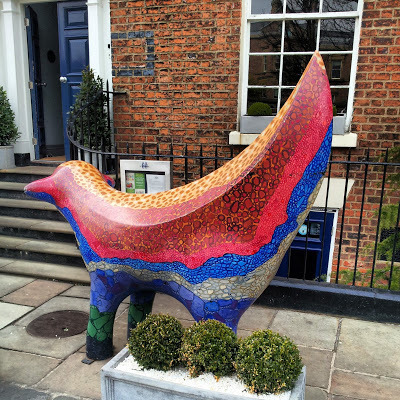
For information about Adam Yamey's published writing,
CLICK HERE !
January 26, 2013
ALBANIA Face of the BALKANS

Some years ago whilst travelling in the south of France, I bought a copy of ALBANIE - visage des Balkans. Published in 1995, it contains a series of reproductions of photographs of Albania taken by members of the Marubi family. Its text is by the renowned Albanian author Ismail Kadare. As it is hard to obtain a copy of this book nowadays, I have decided to present a selection of illustrations from this beautiful book (copied by me with my camera).
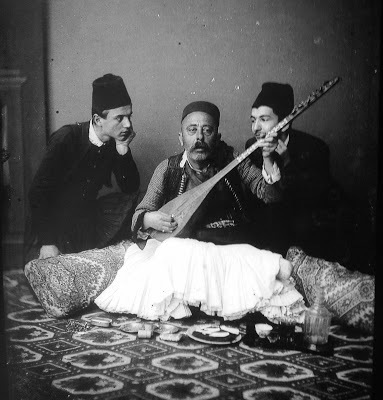
1878: A composer of lyrical verse. Kel Marubi is on our left (Pjeter Marubi, photographer).
The Marubi family went to Albania from their native Piacenza (Italy) in the late 1850s (Click here for more about the family). They settled in Shkodra, a city in the north of what was then an Ottoman province. Albania was a relatively unknown place in those days, and pretty wild on occasion.
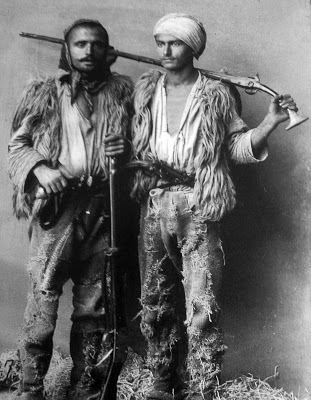
Young insurgents from the Shala region ( Kel Marubi, between 1900 & 1915)
But despite its troubles - banditry, the oppressive nature of being colonised, and the endless vendettas between hostile families - life went on as usual, as can be seen in this picture of men making and selling felt hats ('qelesh').
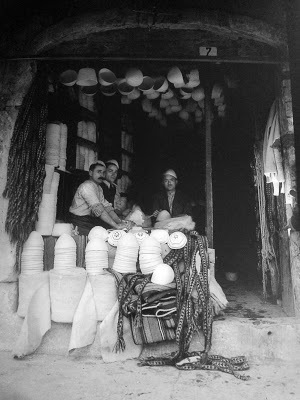
Picture by Kel Marubi taken between 1900 & 1920
In 1925, 13 years after Albania became an independent nation, Ahmet Muhtar Bej Zogolli ('Zog')became ruler of Albania(first as President, then as King).
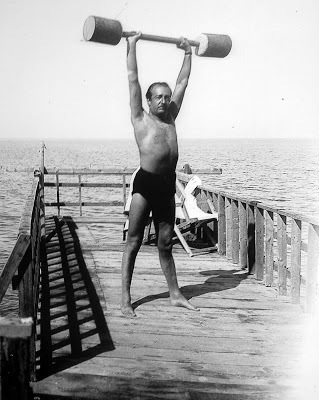
Zog 'working out' on the beach at Durres in 1925 (Kel Marubi)
Zog married the half American/half Hungarian Geraldine Apponyi , the "White Rose of Hungary", in April 1938. Mussolini's son-in-law Count Ciano was present at the ceremony.
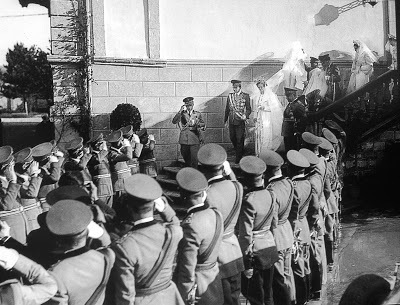
Zog's marriage to Geraldine in 1938 (Kel Marubi)
It was during Zog's 'reign' that the beautiful country of Albania became inextricably entangled with Fascist Italy.
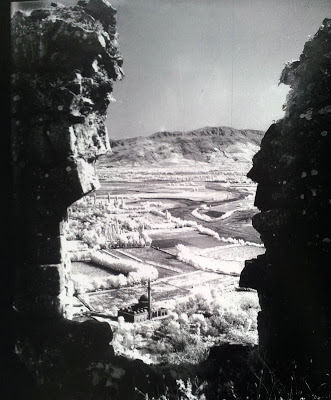
View of Shkodra's Lead Mosque from the Rozafat Citadel (Gege Marubi, 1938)
Zog was attracted to Mussolini's brand of, fascism and the assistance that was offered to him.
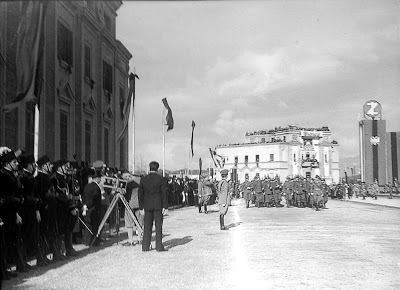
Celebrating 25 years of independence in Tirana (Kel Marubi, 1937)
Mussolini's son-in-law, Count Ciano, was a frequent visit to Albania, and built a hunting lodge on the coast near the small town of Lezhe.
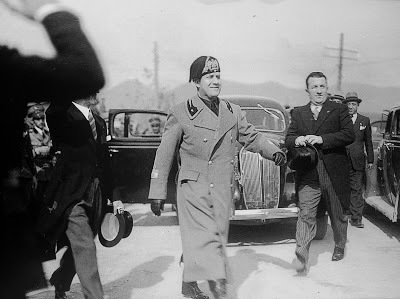
Count Ciano on a visit to Tirana (Kel Marubi, 1937)
In April 1939, Italy invaded Albania. Later on in WW2, Germany dominated the country. Remarkably, Albania was the only German occupied country in mainland Europe where the number of Jews increased between 1939 and 1945. The occupation was resisted by various groups of partisans, each with their own political agendas. In the end, the Communist partisans under the leadership of Enver Hoxha prevailed, and remained in power until the early 1990s.
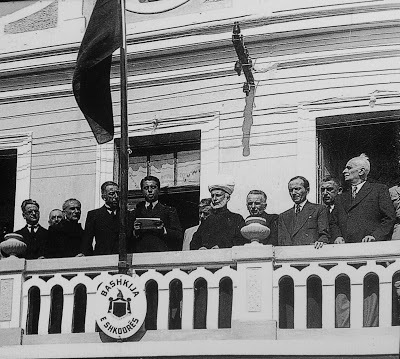
Enver Hoxha reading a speech in 1936 at Shkodra (Kel Marubi)
Under Comrade Enver Hoxha's leadership, Albania became cut off from the outside world. It was more isolated than North Korea is today. Its people were not allowed to travel or to learn anything about the world outside their isolated country. Even thier history was doctored, as can be seen in this retouched version of Marubi's 1936 photograph shown above.
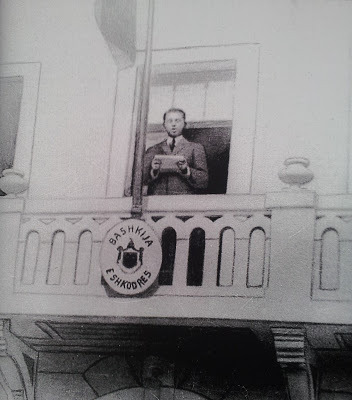
Now, read more about Albania in Adam Yamey's travel memoir:
"ALBANIA ON MY MIND"
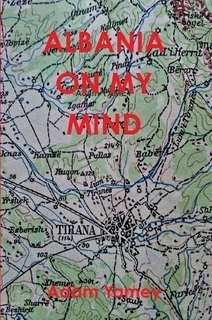
Available in paperback:
http://www.lulu.com/shop/adam-yamey/albania-on-my-mind/paperback/product-20513189.html
and on Kindle:
http://www.amazon.co.uk/ALBANIA-ON-MY-MIND-ebook/dp/B00A7FK1XY/
&
http://www.amazon.com/ALBANIA-ON-MY-MIND-ebook/dp/B00A7FK1XY/
Published on January 26, 2013 08:22
December 9, 2012
TWO FAITHS

The Charminar, a four-arched gateway with four towering minarets, stands in the heart of the old city of Hyderabad in India. It was surrounded by an excessively crowded bazaar the first time that we visited it in August. It was during the last week of Ramadan and everyone was frantically purchasing things in anticipation of the celebration of the end of the season of fasting, Eid. The pressure and crush of the crowds in the baking afternoon sun made us decide not to linger, but to try to return at a quieter time should that exist. In addition, we were hungry, and all the restaurants and cafés were closed because of the fast. However, we did manage to find a milk-bar which was open, and willing to serve us infidels with lassi and rabdhi (sweetened clotted milk).
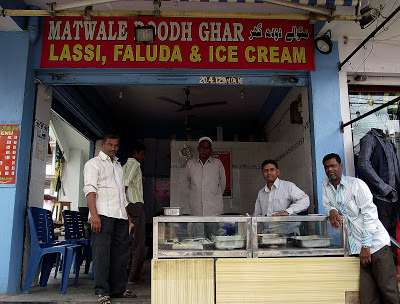
Just before we managed to get an autorickshaw to take us out of the crowded area, I spotted a street lined by colourfully decorated dental surgeries. I would have liked to have explored these had the crowds been less densely packed. We left the area, pleased that although we did not enter the Charminar we had at least managed to see the magnificent Mecca Masjid near to it. This oasis of peacefulness served both as a place of worship and also as somewhere that people could rest or sleep during the heat of the day.

During the following few days, we explored the rest of Hyderabad, visiting the old British Residency, the Golconda Fortress, and the beautiful Qutub Shahi Tombs nearby.
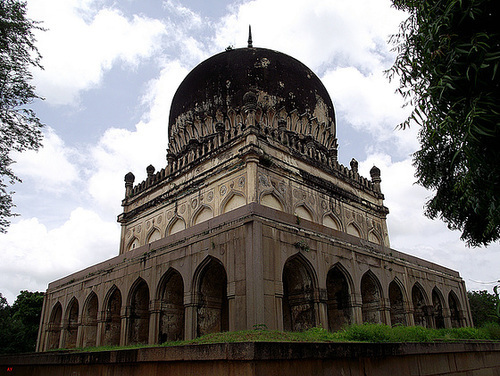 One of the Qutub Shahi Tombs
One of the Qutub Shahi TombsOn the Friday, which was the last Friday before Eid, we returned to the old city in order to see the Charminar once more. Our driver dropped us as close as he could, which was not so close because all of the roads leading towards the Charminar and its neighbour the Mecca Masjid had been closed to vehicular traffic. The police presence was formidable. Armed policemen and airforce-men in blue camouflage combat gear almost outnumbered civilians. We felt as if we were stepping into a war zone. When we asked an officer whether trouble was expected, he answered that it was not and that his men's presence was merely routine. Uncertain about his response, we asked one or two other men in uniform, and their replies were similar.
With the absence of traffic and also of most of the bazaar stalls, movement within the cordoned-off zone was easy. As we neared the mosque and the Charminar, we noticed two things. Firstly, much of the street was covered with green cloths, looking rather like a huge lawn.
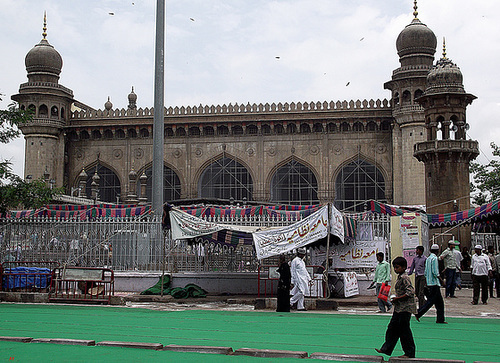
These were patrolled by men in skull-caps, whose job it was to prevent anyone stepping on these enormous prayer mats with covered feet. The second thing that we noticed was that a temporary structure had been attached to one corner of the Charminar.
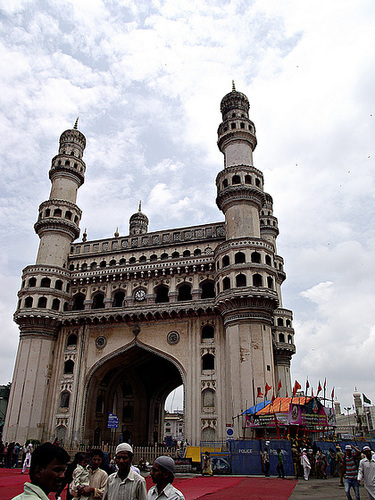
This construction, which had not been present earlier in the week, was a temporary Hindu temple.
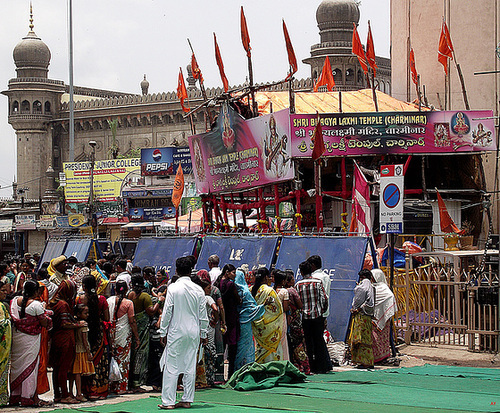
A long queue of worshippers was lining up to worship there. It wound along the gaps between the prayer mats, and there was a heavy presence of Muslim men standing close by to make sure that their prayer mats were not trodden on by the Hindu worshippers, many of whom were wearing sandals.
As the queue of Hindu worshippers moved slowly towards the makeshift temple, we entred the brightly decorated Charminar Dental Hospital.
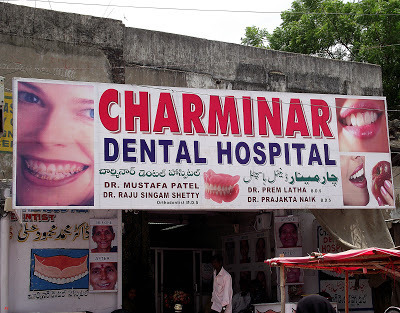 Notice both Hindu & Moslem names on the sign
Notice both Hindu & Moslem names on the signIts friendly owner, a dentist who had qualified in Hyderabad, reconfirmed what we had been told by the police; trouble was not expected. This was difficult to believe given the almost continuous line of armed men surrounding the place. He showed us his clinic and got his assistant to pose on the chair for me.
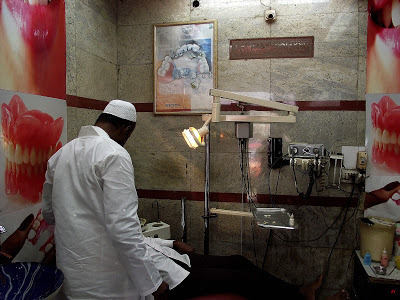
We asked our Moslem host whether he thought that the placing of a temporary Hindu temple on an essentially Islamic monument during one of the most important Islamic festivals was provocative. He told us that he did not think so and they have every right to celebrate their own religion.
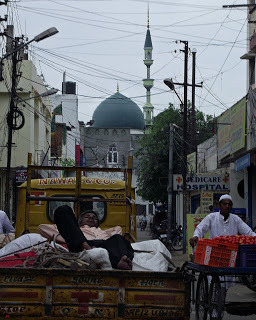
READ MORE ABOUT ADAM YAMEY'S WRITING
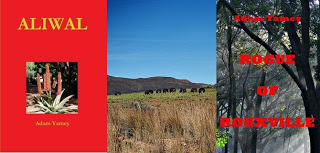
by clicking
HERE !
Published on December 09, 2012 11:13
November 24, 2012
HYDERABAD'S CRUMBLING MASTERPIECE

At first glance, there is little to suggest that the portico in the picture shown above is not part of a Palladian-style country house somewhere in the English countryside. Maybe the two palm trees might lead one to think otherwise, but even in England the occasional palm tree survives the country's often inclement climate. However, it is not in England, but in the heart of Hyderabad in the south of India. It was built to order for James Kirkpatrick (1764-1805), the British Resident at the Court of the Nizam of Hyderabad. Despite the European appearance of this magnificent building, its inspirer, Kirkpatrick, was far from being as conventional as the style of his Residence might suggest at first glance. Having converted to Islam, he married Khair-um-Nissa, the daughter of a senior official in the Nizam's court, and they had two children. His extraordinary tale is related in great detail in White Mughals written by William Dalrymple.
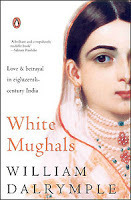
In August 2012, my wife and I motored to Hyderabad from Bangalore. We spent four days in this fascinating city filled with fine examples of Islamic architecturebuilt over a number of centuries. One afternoon, after having visited the huge and eclectic Salar Jung Museum, my wife asked our driver (who hailed from Bangalore and knew nothing of Hyderabad's geography) to drive us there.
Neither I nor my wife had read Dalrymple's book, but the guidebook which we were using, The Footprint South India Handbook, mentioned that the book had been launched in the Residency (in about 2002), and that the building was worth seeing. We set off to look for it, knowing that it is located in the grounds of the Osmania University College For Women, whose grounds stretch down to the left bank of the River Musi. Our only map was that sketched out in the guidebook, and that proved to be unhelpful to say the least! Our driver spoke Telugu, the local language in Hyderabad, and so we asked him to find our way to the University by asking pedestrians and other road users the way.
Many of Hyderabad's public institutions include the word 'Osmania' in thier name, and it was on this word that people whom we asked focussed. Thus, we found ourselves circling the Osmania Medical College, an Osmania Hospital, and many other places that were definitely not the Osmania University College for Women. We knew that we must be close, but our quest was elusive. I was ready to give up and return to the comfort of our quarters at the Secunderabad Club, but my wife was more persistent. She was not going to give up so easily
After driving in ever decreasing circles often along two-way alleys only the width of only one vehicle, we finally homed in on the entrance to the University's compound.
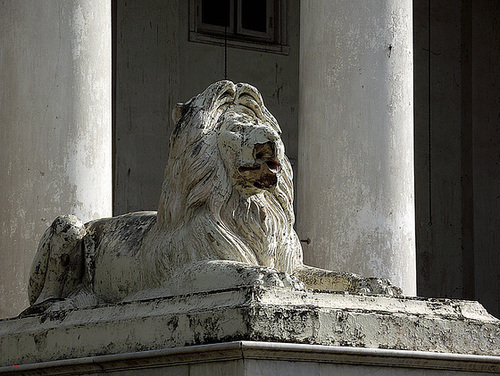
We drove through the gate and parked just inside the grounds. Moments later, an angry watchman came running up and asked us what we were doing entering the private College grounds. My wife told him in Hindustani that we had to meet with the Principal. The watchman pointed out the Administration Block and my wife disappeared inside. Meanwhile, we were allowed to drive further into the grounds, and I disembarked outside the grandiose portico of the former British Residency, its steps flanked by two carved lions in a poor state of preservation. I stood waiting in the hot sunshine. Groups of students, many of them wearing head scarves or hijab, passed, carrying folders and bundles of books under their arms.
A few minutes later, my wife arrived along with a young man from the office. He informed us that the Residency was in a poor state, and that it was unsafe to enter. Nevertheless, he unlocked it, and we entered.

A door at the rear of the building gave us access to the interior. We followed our guide to the magnificent main staircase, which we climbed.
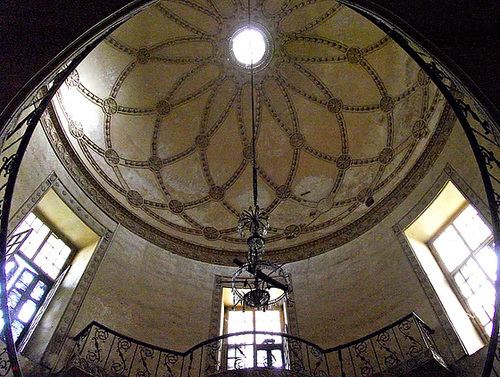
At the top, we entered a gallery that looked down on to the ballroom.

We returned back down the staircase, trying to avoid touching its fragile, barely attached handrail and visted some of the rooms at the building's rear. Many of these were litterd with books and desks. They had been used as classrooms until recently.
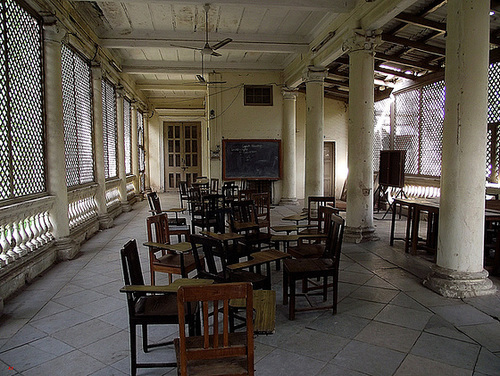
Our guide took us back into the front part of the building and into the grand ballroom.

Now the home of pigeons and no doubt other pests, Kirkpatrick's crumbling Residence is in danger of imminent and sudden collapse. I am not sure how many heavy monsoon downpours this fragile architectural gem will be able to withstand.
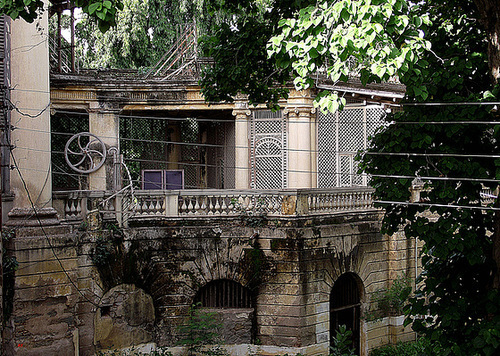
Listed as a Protected Building by the Archaeological Survey of India, and also by the UN, this building continues to disintegrate because of lack of funds as well as administrative squabbles such as those that hinder the preservation/restoration of other valuable historical sites in India.
We feel privileged that we were able to view this building at such close quarters, but hope that we are not amongst the last to do so!
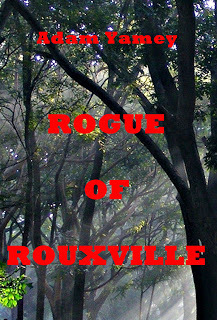
READ ABOUT ADAM YAMEY's published works byclickingHERE
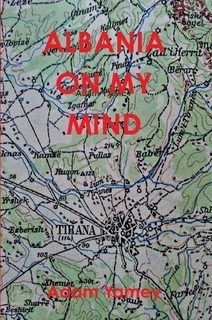
Published on November 24, 2012 04:50
November 16, 2012
A BUNNY & A BARISTA
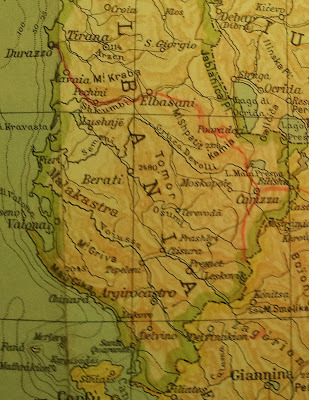
The red line shows the route takebn by an Italian soldier crossingAlbania in 1941 during Mussolini's invasion of Greece
Having been successively occupied by The Ottomans (for several centuries), the Italians and then the Germans, it is not at all surprising that the traditionally hospitable Albanians became somewhat suspicious of foreigners by the end of the Second World War. This xenophobia , which was exploited by Albania's dictator Enver Hoxha, led to Albania adopting an isolationist approach rivalled only by countries like Mongolia (until recently) and North Korea (still today). The following is a brief introduction to Adam Yamey's new book Albania on my Mind. It includes quotes from the book.
When I became a dentist in 1982, the idea of ever treating a patient from Albaniawould have seemed almost as unlikely as meeting someone from Mongolia. Both were places that hardly anyone visited from the West, and from which visitors to the West were few and far between. Well, 30 years later, everything has changed. Almost daily I treat Mongolians and Albanians (both from Albania itself and also from Kosovo). Whilst I have never set foot in Mongolia, I have visited Albania.
I visited the country in 1984 when it was even more isolated from the rest of the world than North Korea is today. In those days, Albaniawas firmly under the control of Enver Hoxha, a dictator who counted Josef Stalin as his friend and inspirer.
Occasionally, when chatting to my patients from Albania(in English), I relate curious incidents that I recall from my short, but illuminating visit to Hoxha’s heavily guarded stronghold. Some of my audience are too young to remember life under the dictatorship, but those who are old enough say that what I relate is only too painfully true. One gentleman, aged about 45 and brought up in Albania, said after hearing one or two of my anecdotes: “You must write these things down. No one believes me when I tell about how terrible it was living in Albania in those times, but they will believe you, an observer from the outside world.” And, that is exactly what I’ve done in my book Albania on my Mind.
My book is divided into two main sections. The first deals with how I became obsessed with Albania, and the second contains a collection of memories of the trip I made there in 1984.
My interest in the country began when I used to spend, “…much of my spare time during my mid-teens haunting second-hand bookshops. In the second half of the 1960s, Hampstead Village, which was in easy walking distance of my family home, had at least 5 such establishments. My favourite store… was run by a scholarly old man. He sat reading in his untidy shop, surrounded by books, which were scattered disorderly on every available surface including the floor. Every now and then, he used to burst out laughing and would then read aloud, often in Latin, to whoever was in his shop. …I found and bought a number of old world atlases in his shop. Most of them were published between the two World Wars. I used to spend hours leafing through them, admiring their beautifully drawn maps. … One day, whilst examining one of my atlases, I saw a country, which I had not noticed before. It was Albania.”My curiosity about Albaniawas aroused. I needed to know more about this place, about which so little information was available in the 1960s. Even today, not many people know much about it.
As the years passed, I made numerous trips to places in the Balkans from where I could catch a glimpse of the country which was beginning to tantalise me. On one trip, I took a bus over the CakorPass which links Kosovo with Montenegro. It traverses the mountains shared by these places and Albania. When the bus stopped at the top of the pass, “…a grubby little boy approached me. He said something to me in a language, which I did not recognise as being Serbo-Croat. It was probably Albanian. Somehow, he made it clear to me that he wanted foreign coins. I thought that he was either a beggar, or more likely, just a curious youngster pleased to have chanced upon a foreigner. I gave him a few British coins, and then he rummaged around in his pocket. After a moment, he handed me a few Yugoslav Dinar coins, and left. He was no beggar, after all, but simply a young fellow with a well-developed sense of fairness.”
Although it was impossible to speak with Albanians in Albania - contact between them and foreigners was strictly discouraged by the authorities - I did manage to discover how friendly they are when I stayed in Kosovo, the part of Serbia which has an enormous Albanian population. When I disembarked at the bus station in the Kosovan town of Prizren sometime in the 1970s,“…I was immediately surrounded by people, mostly young men. Everyone wanted to know my name, rather than my nationality or where I had come from. When I said it was ‘Adam’, they then asked me whether I was a Moslem. The answer did not seem to matter to them; they were just pleased to meet a stranger.”Contrast this with what happened within 12 hours of my arrival in Albaniain 1984:“After lunch, the Australian, who was travelling with us, called me aside, looking shocked. He told me that when he was in the hotel’s lift, an Albanian couple began to strike up a conversation with him, but stopped abruptly mid-sentence. It was, he felt, as if they were keen to speak to an outsider, but became scared of the consequences of being caught doing so. Maybe, they had been worried, not without reason, that the lift might have been fitted with a hidden microphone.”In fact, whenever anyone wanted to try to talk to us in the country, they were warned against doing so by others standing nearby. Even our Albanian guides were wary of what they said to us. We, the foreign tourists, were regarded not only as guests (the guest is held sacred by traditional Albanians), but also as potentially dangerous intruders from the hostile world beyond Albania’s hermetically sealed borders. They were constantly keeping an eye on each other as well as us.
My trip to Albaniawas a truly remarkable experience. I am certain, “…that the Albanians did not regard us as being simple tourists, but rather as potential messengers. We were being shown the country with a view, so our hosts hoped, to providing us with information that we could use to broadcast to the world how well Albania was progressing along the isolationist path it had chosen to take.”I am not sure that the message we took home was quite what the Albanians had hoped. We were taken around a factory, of which our hosts were very proud. It purported to make precision instruments, but, “… the sliding (Vernier) calliper, which had been made in the factory… was a crude object, whose jaw slid jerkily rather than smoothly. The markings were badly scored and looked a little irregular.” ‘Precision’ it was not!And, although the Albanian-built tractor on display at an exhibition of Albanian industrial products in Tirana,“… differed in design from the Chinese tractors that we had seen on our travels, we had not seen even one of these home-made machines anywhere outside the exhibition.”Nor, could I find outside the exhibition any samples of the “…yellow plastic bunny rabbit holding a rifle in exactly the same pose as the soldier, who had watched our arrival at the Albanian frontier.” I would have loved to have bought one of these to protect my garden.
It is easy to criticise, but one must not forget to praise. Even if I was unable to meet many Albanians on the tour I made in 1984, I cannot fault our hosts on the care that they took to make sure that we were comfortable and well-fed. Although their main interest appeared to be to ply us with propaganda and to show us what they wanted us to see, they showed us a great cross-section of their beautiful country.
I have not revisited Albaniasince 1984, but would like to do so. Never in my wildest dreams in my younger days did I imagine that I would now be able to slip out of my surgery, enter a neighbourhood café, and then order a cappuccino from an Albanian barista. And, the smile of gratitude, which I receive when I thank him by saying ‘faleminderit’ and shout ‘mir u pafshim’ when I leave, melts my heart. Even as I write this piece, I realise that although many years have passed, I still have Albaniaon my mind.

ALBANIA ON MY MIND is available in Kindle on Amazon web-sites&in paperback by clicking HERE
Published on November 16, 2012 01:22
November 12, 2012
ALBANIA
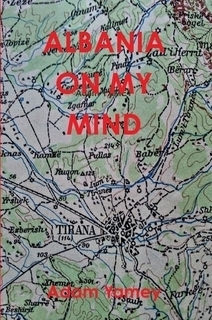
ALBANIA ON MY MIND
by
Adam YAMEY
“It struck me that Albaniawas the sort of place that might keep a man from yawning” [ From The 39 Steps, JBuchan,1915]
The people of Albaniaachieved independence in 1913, having endured several centuries of Ottoman domination. After the First World War, they lived under a series of dictatorships beginning with that of King Zog. He was followed by Mussolini, and then by Hitler. They were ‘liberated’ by the Communist partisans at the end of the Second World War, only to be subjected to yet another dictatorship. This was led by Enver Hoxha. During his 30 year ‘reign’ Albaniabecame even more impenetrable to outside observers than North Korea is today.
Hoxha rejected his close allies, the Soviet Union and then later the People’s Republic of China, and then tried to make his country to become self-sufficient by isolating it from the rest of the world.
In this book about Albania, published to celebrate 100 years of Albania’s independence, Adam Yamey describes how his almost obsessive interest in the country developed and what he discovered about life inside the country’s closely guarded, tightly sealed borders when he managed to visit it in 1984, the last year of Enver Hoxha’s life.
Available in paperback by clicking HERE
Published on November 12, 2012 14:46
November 2, 2012
PACKAGE FROM ALBANIA
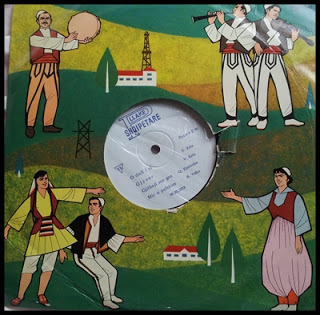
Excerpt from my forthcoming book "Albania on my Mind"
Ihad a Phillips radio in my bedroom. It was a valve radio, rather than the more modern transistor-based instruments, which were already available in the 1960s. Once it had warmed up - a slow business taking up to a minute - and had stopped emitting crackling sounds, it was able to receive broadcasts on three wavebands including short-wave. I used to enjoy twiddling its tuning knob, and listening to broadcasts transmitted from all over the world. It was a window to the world beyond the confines of the highly manicured, desirable but rather dull, Hampstead Garden Suburb, where we lived.
One day, I tuned in on an exceptionally clear transmission, and listened with some curiosity and a great amount of surprise to a woman who was speaking perfect English with only the hint of a foreign accent. After a few minutes, she informed her audience far and wide that they were listening to the voice of Radio Tirana. I could not believe my ears. I made a mark on the tuning gauge to ensure that I would be able to find this station again. I tuned into Radio Tirana regularly, listening with astonishment and also amusement at the various commentators’ beautifully articulated words - mostly rants and raves directed against the actions of the imperialists and capitalists. These were punctuated by stirring Albanian songs sung in a style that was new to me, as I had never experienced the music of the Balkans before.
After a short while, I decided to write a letter to Radio Tirana. Somewhat tongue in cheek, I wrote to the unknown addressee (in English) that the songs, which were being broadcasted from Albania, inspired me greatly and helped to reinforce my faith in Socialism. After addressing the letter’s envelope to ‘Radio Tirana, Tirana, Albania’, I waited with little expectation of receiving any kind of reply. I thought that it was more likely that I would receive a communication from MI5 or MI6 than anything from Albania. However, I was wrong to have been so pessimistic. A flat parcel, wrapped in brown paper and string, arrived by post a few weeks later. It was from Albania. I unwrapped it carefully, my fingers thrilling at the thought of handling something that had arrived from the mysterious country that had begun to interest me so greatly.
The package contained a 10-inch diameter long-playing gramophone record in a garishly coloured cardboard sleeve. It was decorated with an electricity pylon; musicians in folk costumes; dancers dressed likewise; a man wearing baggy Turkish-style pantaloons; and an oil derrick. The plain, unadorned record label bore the name of the recording company: Pllake Shqipetare (‘Shqipëria’ being the Albanian word for Albania)...
Now, why not read "ROGUE OF ROUXVILLE" ?
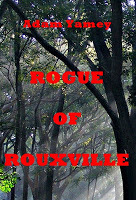
Dicing with debt, Jakob Klein struggles to support his growing family. He'll stop at nothing to achieve this. His dubious business ethics inevitably lead him into trouble with the law. He is imprisoned. His family have to flee from the small town in the Orange Free State, where they have lived.
What wll become of them, and of Jakob? Will they ever be reunited?
Read all about it in Adam Yamey's historical novel "ROGUE OF ROUXVILLE", available on AMAZON (Click HERE FOR KINDLE) and also on www.lulu.com (Click HERE FOR PAPERBACK ) .
For more details, click HERE
Published on November 02, 2012 05:15



